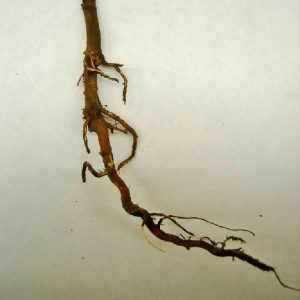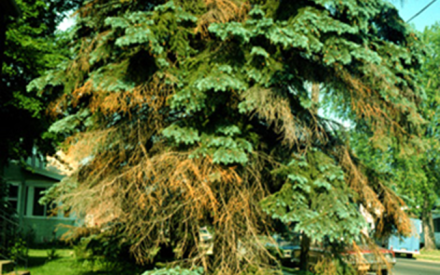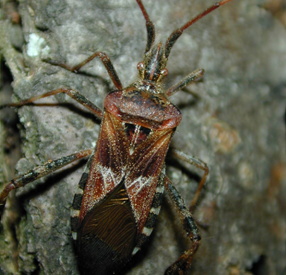
P.J. Liesch and R. Chris Williamson, UW-Entomology
Revised: 5/20/2013
Item number: XHT1208
White grubs (i.e., larvae) of the common May/June beetle or “Junebug” (Phyllophaga spp.) are an important pest of Christmas trees in Wisconsin. This soil-dwelling pest feeds on the roots of pines, firs, and spruces, and can cause damage severe enough to kill small trees in Christmas tree production fields.
Appearance: Adult May/June beetles are typically ½ to one inch long and vary in color from reddish-brown to almost black. Adults are active in late May and early June, often flying near house lights at night. May/June beetle white grubs have a distinctly C-shaped, cream-colored body with a reddish brown head and three pairs of legs. Grubs vary in size (depending on their stage of development), and can be up to 1¼ inches long when fully mature. Larvae have strong mandibles (i.e., mouth parts) that they use to chew on the roots of small trees.
Symptoms and Effects: Adult May/June beetles occasionally cause damage to trees by feeding on leaves and needles. In contrast, May/June beetle larvae can be extremely damaging to young conifers. White grubs damage young trees by feeding on their roots and interfering with the uptake and transport of water and nutrients within the trees. The initial symptoms of grub damage appear similar to those of drought stress: mild yellowing and wilting of trees. When feeding damage to roots is severe, trees turn brown, often shed needles and typically can be pulled easily from the ground. Small conifers (e.g., 2-2 or 3-0 trees) in Christmas tree production fields are often most susceptible to white grub damage due to their small root systems. In contrast, larger trees with more developed root systems can tolerate some white grub activity without major consequences.
Life Cycle: May/June beetles typically have either a two- or three-year life cycle in Wisconsin depending on species. Adults emerge in late May to early June and are
active in the evening hours. Adults mate, and females lay eggs in the soil. After emerging from eggs, white grubs begin to feed below-ground on plant roots. Larvae pass through three stages (called instars) and become progressively larger and more damaging. Depending on the species of May/June beetle, larvae begin pupating in the soil in the late summer and fall of the either the second or third year of their life cycle. The next generation of adults emerges the following year.
Control: An integrated approach to control that includes cultural, physical and chemical practices can help prevent or at least minimize the effects of white grubs. Control practices should include the following:
Scout fields prior to planting to identify potential white grub problems. Not all fields have problems with white grubs. If you sample with a hand trowel and find average grub densities of ½ to one or more grubs per square foot, grub control measures are warranted. Similarly, if you sample with a tree planter and find grub densities of approximately 1½ to three or more grubs per ten linear feet, grub control measures are warranted.
Apply insecticides when white grub densities are high to help prevent root damage to small trees. Grub control products for Christmas tree farms include products containing bifenthrin, imidacloprid, and thiamethoxam. You can directly apply these insecticides into the root zone of trees via soil incorporation or root dipping, or apply them as banded sprays. If you opt for a spray treatment, be sure to use a relatively high spray volume (i.e., 44 to 220 gallons/acre), and apply the insecticide prior to a forecasted rain to ensure proper movement of the product into the soil profile.
Manage weeds in production fields using a chemical herbicide. This will deter May/June beetles from laying eggs in the treated area. Female May/June beetles prefer to lay eggs in weedy or mowed grassy areas.
Additional Images

Download Article





 Phytophthora Root Rot of Christmas Trees
Phytophthora Root Rot of Christmas Trees Cytospora Canker
Cytospora Canker Western Conifer Seed Bug
Western Conifer Seed Bug Conifer Disease Quick Reference
Conifer Disease Quick Reference


